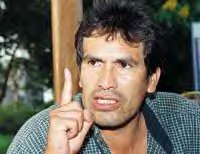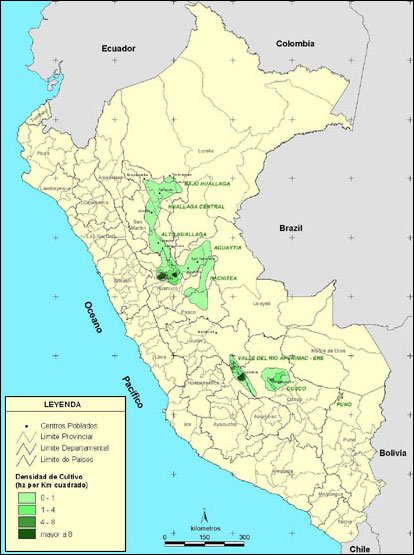


Peru Before the Battle
The Coca Growers on the Verge
By Luis Gómez
Part I of a Series about the Drug War in Peru
February 27, 2004
In Peru they describe Alejandro Toledo as the least popular president in Latin America (his government’s favorable rating barely reaches seven percent). Meanwhile, the new forces of resistance are bearing fruit. The Peruvian coca growers have marched on the capital of the country, and have met to discuss their strategy in the fight, and have succeeded in shaking the political stage of the country.
Led by Nancy Obregón, more than a thousand farmers showed up from Thursday, February 19, to Sunday, the 22nd, in Lima, and there we begin: The first resolution passed called for the immediate freedom of their maximum leader, Nelson Palomino, arrested on February 21st, a year ago.
 Nelson Palomino Photo: CONPACCPER |
This story, as you will see, kind readers, has a long tail. Last April, during the march by ten thousand coca growers who took downtown Lima to push the government to hold talks, the coca growers’ leader Elsa Malpartida explained: “We have been tricked for years. We have signed thirteen agreements that were never complied with. Now we have decided to obtain all of our rights.”
So, before we go with the coca growers to Lima, let’s review a few recent events…
The Famous State Department Report
Last November 17th, the gringo State Department delivered what many consider to be the basis of all the abuse and interdiction: its Estimate of Coca Crops for Bolivia and Peru. The report is released annually, according to what U.S. officials say, based on images provided by the Landsat satellite.
Last year, “curiously,” the report created the pretext to increase eradication campaigns in the Yungas region of Bolivia, since according to the document the coca crops had increased by 26 percent in this region where coca has been cultivated for thousands of years. In an interview published on November 20, 2003, in the Bolivian biweekly El Juguete Rabioso, coca growers’ leader and Congressman Dionicio Nuñez offered his view of the matter to this journalist: “This is a kind of order from the U.S. State Department to Bolivian authorities to tell them to eradicate coca.” And, in fact, in those days the coca growers of Yungas caught a rural police patrol “constructing” a coca manufacturing plant in the region, which generated a huge conflict, resulting in various peasant farmers wounded by gunshot…
And in Peru? Well, the cited report explains that there had been “a 15 percent drop in coca crops in 2003.” According to the U.S. government, the cultivation of sacred coca in Peru dropped from 36,000 hectares in 2002 to 31,150 in 2003. “However,” the little report continued, “the crops in the Apurímac-Ene valleys and in Monzón – areas where coca for traditional use is grown in small parcels – remained stable. These areas represent 67 percent of the illegal coca in Peru.” It wasn’t clear what they meant – “areas of traditional coca cultivation?” – And, “illegal coca” is grown there? The report wasn’t very clear on that point, because if there are areas of traditional cultivation, that is defined as a place where coca is grown for uses such as chewing, medicines, or ancestral rituals, and it is simply not possible to speak, then, of illegal coca. Kind readers: Did someone from Colin Powell’s office kick the ball into its own net? Or are these men manipulating the information? What do you think?
Maybe this map elaborated in 2001 by the office of Peru’s drug czar, Nils Ericsson, could prove useful:
 Devida-Perú |
As you can see, there are three green marks, that represent the coca growing zones in Peru. The second largest corresponds to the Apurímac-Ene Valley. And the smallest fo the three, with the word “Cuzco,” is another well known traditional area. The majority of these crops, located in the center of Peru, are in Huallaga and other regions, among them the coca growing center of Monzón (in the dark green parts). Things being what they are, how could these regions produce the largest quantity of coca by themselves? One of the many mysteries that we will begin to resolve right now…
Meanwhile, let’s stay with this report. Among the repercussions that it had was upon the office of Peru’s drug czar, also known as the National Commission for Development and Life without Drugs (DEVIDA, in its Spanish initials), presided over by the aforementioned Nils Ericsson. The day after the State Department report appeared, DEVIDA informed, through a press release, that “As of November 15th we had eradicated 8,555 hectares, surpassing the goal of 8,000 hectares” in the previous year. Or, in other words, from the 36,000 hectares there had been in 2002, they eradicated 8,555 and only 28,000 remained… But didn’t the gringos say that there were 31, 150? What happened?
Well, the same thing as always happens: According to U.S. anti-drug “experts,” each time that coca crops are eradicated, people start to grow the leaf in other areas. So the eradication doesn’t really count for anything… That’s how Peruvian authorities decided to take various paths to demonstrate their effectiveness and their goodwill to do their part in the so-called “War on Drugs.” And all this occurred in a 320-word report from Washington!
Broken Treaties and Tricky NGOs
In spite of all the weeks of drug seizures in Peru, and all the dossiers documenting the nature of criminal drug trafficking (almost all of them related to the “white gloves” of the mafias), the Peruvian government launched an offensive at the end of last year that had, among its goals, of course, attacking the organization of peasant farmers that grow coca. On November 21, 2003, in an operation named “Valley III, Phase III,” the anti-drug troops entered the Apurímac-Ene valley for five days, breaking a new record of 66 drug labs destroyed, and mountains of seized chemical precursors and a 21-year-old boy placed under arrest… Who did they accuse, then, of fomenting drug trafficking?
Of course, the only ones who have the resources to buy and transport construction materials and chemical precursors: they’re the peasant farmer coca growers! However, in the name of the peasant farmers of the region, the leader Marisela Guillén categorically denied it to the Interior Minister: “We have nothing to do with narco-trafficking. We defend the coca leaf.” Guillén stated, also, that, “We want all that money to be invested in crop substitution. And that money that comes from abroad should be invested directly in the small parcels of land of the peasant farmers, who obtain their only livelihood from those lands.”
Guillén’s statements, made in a December 7th interview in 2003 with the daily newspaper, Ojo, were not the only such statements. The peasant farmer leader also spoke about the most recent agreements between the coca growers and Alejandro Toledo about the roles of narco-trafficking and Non Governmental Organizations involved in the conflict. Let’s recall some of Marisela Guillén’s responses:
Ojo: Then, what do you want?Marisela Guillén: We agree with the gradual reduction and concentration of our coca fields, but we want that they will also leave us with the minimum crops that we need.
Ojo: Do you accept the Supreme Decree #044 that was signed in the National Palace for a gradual and consensual reduction?
Marisela Guillén: Yes, of course, but it’s the government and its agencies that are not obeying that decree.
Ojo: How does that happen?
Marisela Guillén: The agencies named DEVIDA and CHEMONIC are obligated to erradícate the crops of coca growers who have parcels smaller than those which produce two to five crops to survive, but they do nothing against the big plantations. They also offer farmers $180 dollars to eradicate, but once they eliminate the crops, they only give $49 dollars, and nothing more, and they don’t comply with the public works they agreed to do. There are many cases of this.
Ojo: Will you do the same thing to “CARE” that you did to the previous agency that was expelled from the Valley?
Marisela Guillén: We will do that because they only serve to abuse the name of the peasant farmer and take advantage of it.
Ojo: And nothing has changed with the new agency, CHEMONIC?
Marisela Guillén: It’s the same as “CARE.” They are doing the same thing. Nothing has changed. The worst thing is that they are looking for conflict, they are abusing the natives (Asháninkas) in the Ene region to eradicate the crops of the locals in the region. They’ve given them a pittance to eradicate the coca of others. They are also inciting violence. They want to divide the farmers who have signed the agreement of crop reduction from those who have not signed it. What is happening is an outrage.
Ojo: And the coca that you produce doesn’t go to drug traffickers?
Marisela Guillén: There are some coca growers that still are not conscious of what they should do because there are some buyers who use this coca for narco-trafficking. But they also sell coca for traditional uses of chewing.
Ojo: How much does ENACO (the National Coca Business) pay compared to narco-traffickers?
Marisela Guillén: ENACO pays 50 soles per bushel while the others pay 60 or 70 per bushel. But, let’s be clear: we have three markets.. ENACO, the businessmen who bring it to the mountains, and the drug traffickers… the coca growers don’t ask who is who. They just receive payment from he who pays best. We want to line up to sell it only to ENACO. And any farmer who falls into the crime of drug trafficking will be punished severely by our own Federation and will not receive any defense.
Ojo: Are you thinking about a new offensive?
Marisela Guillén: We are thinking about marching to Lima once more, to make the City of Lima see us, because we are under attack and the government is not complying with its own Supreme Decree # 044 that we signed in the National Palace.
Did the compañera make her position clear? This reporter wants to know. Yes, she did. Not only did she make the needs of Peruvian coca growers very clear, but she also explained how Toledo’s government broke the agreements that were signed after the marches of April 2003.
Still remaining is the matter of the mess made by Non-Governmental Organizations (NGOs) in Peru, who not only caused the imprisonment of Nelson Palomino, but who also harassed and tricked the coca growers, and made themselves accomplices of the repressive policies of this country.
Now that Marisela has spoken about marching on Lima… put on your seatbelts, kind readers, because the road is long and you have to walk it on foot (or, if you’re lucky, in the back of trucks)… and in the road to Congress we still have some surprises to come (by air and by sea)… And in this tour the battle has only just begun…
Lea Ud. el Artículo en Español
- The Fund for Authentic Journalism
For more Narco News, click here.




